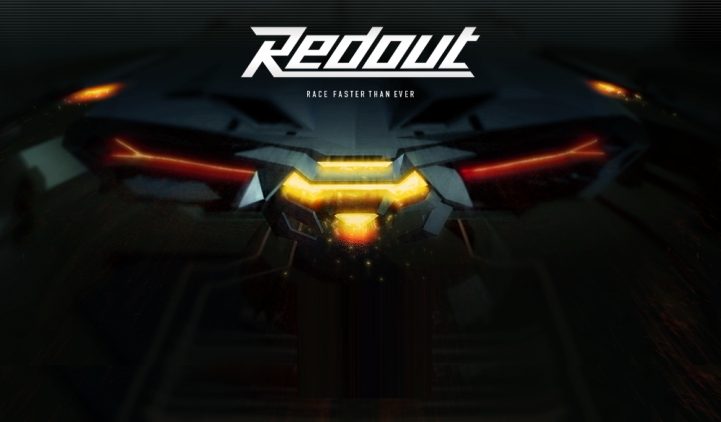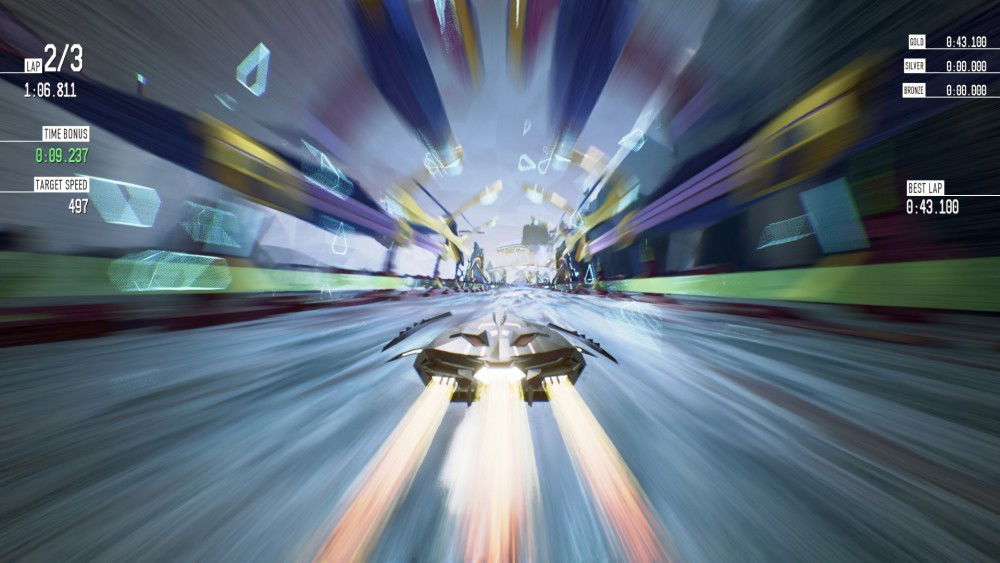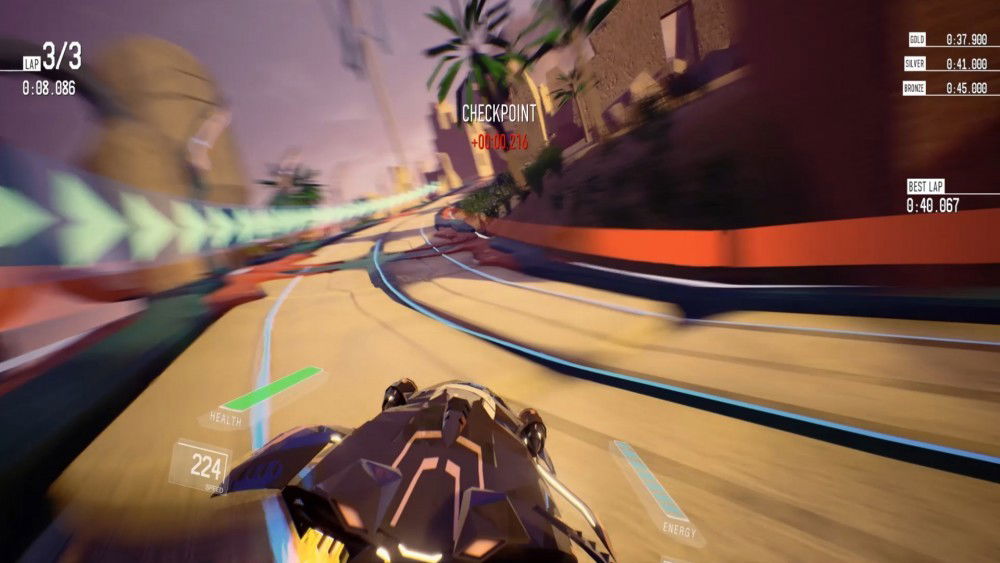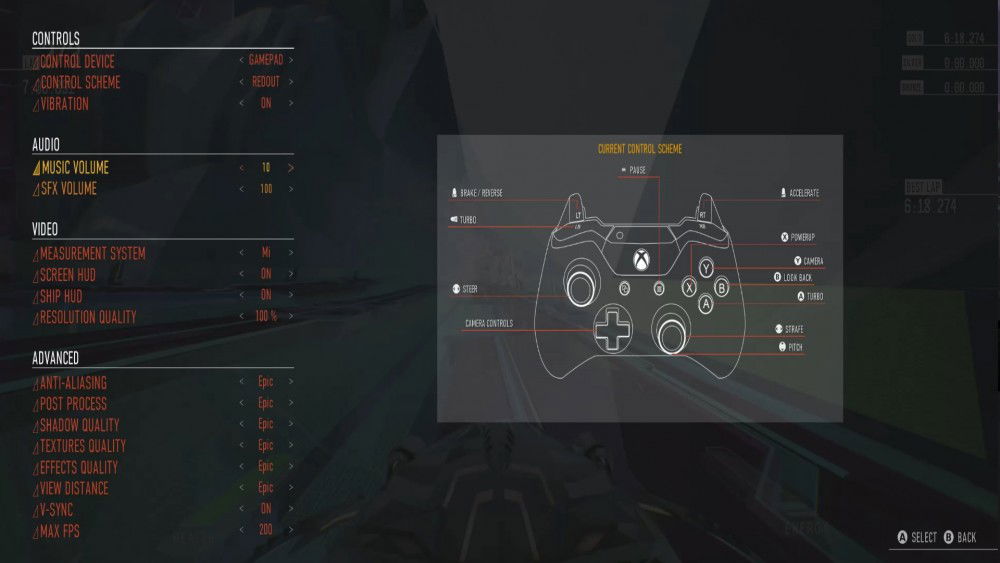It seems like a once thought dead genre; anti-gravity / futuristic racing games have been making a comeback for the past year. I’m not talking about the emergence of one or two, but at least six games that I’ve counted so far. Out of those, Redout is the only one that has made it out of early access/ beta access and retail. That said, I plunked down my cash and picked up the newly released futuristic racing title to see if it was up to snuff.
Game Name: Redout
Platform(s): PC (now), PS4 and Xbox One in 2017
Publisher(s): 34BigThings
Developer(s): 34BigThings
Release Date:
Price: $31.99 for the first week, $34.99 normally
Get it on Steam here.
*Redout is compatible with both the Oculus Rift and HTC Vive. However, due to not having access to either one, the VR component was not tested.*
Redout is being touted as a tribute to previous racing titles such as Wipeout, F-Zero, Rollcage, and even POD (Anyone remembers that game?). That’s some pretty high-heeled shoes to fill, especially since several of those titles mentioned have a huge following, really passionate fans. I happen to be one of those fans and have played just about every arcade and anti-gravity racing game in existence. Ever since I found out about Redout via a friend several months ago, I’ve been following the title’s development. And while I’m spoiling the review from the start, I’m happy to say that Redout does exactly what the development team behind the title, 34Bigthings, set out to do. However, they didn’t just give us yet another futuristic racing game. They’ve added a few updates that help separate the game from the pack.
What’s different?
One of those updates is the ability to upgrade your vehicle. In Redout, you aren’t stuck with several vehicles with a preset amount of traits. Instead, you’re given several options to modify your vehicles.
At the start of Redout, you’re given one vehicle that you can either upgrade by modifying its stats; Turbines – affects acceleration, magnets – increase grip, structure – how much damage you can take and energy – how much boost you can use and how fast it recharges. Each vehicle can be added to one level per stat within a class, of which there are five classes. You don’t have to upgrade your vehicle, it’s not recommended as the races get tougher the further you progress in the game, but you don’t have to. Instead, you can change up to a different class of your vehicle, assuming you’ve amassed enough credits and have reached the required level to purchase the vehicle. This adds a whole new level of complexity as you can basically own multiple vehicles, each with its own strengths and weakness, perfect for tackling multiple tracks.
Redout also handles power-ups differently compared to other games similar to it. Instead of collecting powerups off the track during the race, you’re given the option to purchase them, should you have enough credits. Every ship can handle two power-ups; active and passive. Active power-ups are typically weapons manually fired, whereas passive provide additional stat upgrades to your vehicle. This way, power-ups aren’t random, and you always know what you’re using when going into a race. I can see why other games didn’t include this, yet I prefer it after using this system. I like knowing that I’ll go into a race with missiles every time vs. randomly acquiring a powerup. This also means there are no surprises and that there’s no one almighty weapon (Read: Blue Shells) that can drastically alter your race.
The last major change is how the game handles damage. Sure, if you happen to fly off the track, which only happens if you mistime a jump, you’ll blow up. However, traditional damage such as running into or smacking the sides of the track will still damage you. But if you don’t get hit much afterward, you’ll begin to repair. This addresses a huge issue I had with this genre. You shouldn’t lose time due to an explosion because you’re not a pro or because you didn’t make it to a repair pad in time. I applaud 34BigThings for implementing this.
And those credits you need to purchase upgrades or new vehicles are earned by winning races. The better you place, the more you win, and the faster you rank up levels. So, race, win, upgrade, profit!
What about racing?
Without a doubt, Redout is one of the fastest anti-gravity racers I’ve played. That’s including games of the past as well several other in-development AG racers that I’ve played. The sense of speed is definitely one of the major draws of the game. After playing Redout for multiple sessions and going back to another unnamed racer in the same vein, it was notably slower. That’s how well the speed is represented in Redout. Mind you, that’s without even upgrading my default vehicle or engaging the boost in a race. However, once I did manage to upgrade the vehicle, it got faster, and with the boost button pressed, it resembled a scene out of Star Wars, whenever a ship hit hyperspace.
Graphically, Redout doesn’t have many peers that can do what it does. Every track in the game is super detailed. The environments, the backgrounds, even the raceway, is highly detailed. It’s as if each track was given its own personality. For example, the Cario, Egypt stages feature a raceway made up of brick, while sandstorms kick up during the race, or with the Alaskan stages where the tracks are compromised of winding paths with blue and purples hues as if it was made up of ice. The later stages even more impressive, and I’ll leave it at that. There’s just so much more going on throughout every race than just the race itself. The game is such a beauty in motion; at times, it won’t matter how good or bad you’re during as most of the time, you’ll be mesmerized by the tracks themselves.
The vehicles, however, are a different story. Many of them look like basic models with their textures left off and rough looking. Yet as you play the game, you’ll see shadows and reflections cast onto them as you race. It just looks off, yet this seems to be the look that 34BigThings was going off, as there’s no way they’d waste time putting all the particle effects and reflections on the vehicles if the models weren’t where they wanted them to be. On the other hand, every vehicle has some animation for when it turns or strafes, which is actually pretty cool and shows how much work went into even the little details. Before warned folks, if you have issues with tons of visual stimuli, Redout may actually be a little too much to bear.
When it comes to the sound department, Redout doesn’t disappoint, and I was really impressed with how well each vehicle’s sounds were portraited. A great example of this comes from just listening to your vehicle as it sits idle. There’s a subtle hum coming from the engines, which gets louder and more increased as you start to accelerate. The sounds it produces are also futuristic as it doesn’t sound like something you’d hear from a V6 or V8 engine, but almost electronic. Letting go of the acceleration produces the exact opposite, producing a pleasing hum until the vehicle comes to a stop.
The soundtrack is also worth mentioning as it does something that no other racing game I’ve played has done. Similar to what was done to the Killer Instinct fighting game, each stage’s soundtrack is dynamic. Just sitting at the starting line will give you generic-sounding music. However, once you start to move around the track, the music changes and will continue to do so as you race around the track or perform something throughout a race. At one point, I swore that the music actually lowered itself and increased the wing noise as I jumped over a ramp. It was only after I recorded that race and did it again that I realized that was exactly what happened. It’s an amazing effect for sure.
The controls are the one thing that can make or break even the best racing title. Here’s where Redout seems to be a mixed bag. You’re given three different control schemes, and they’re all pretty much the same except how the air brakes work. With Wipeout games, you had access to the left/right triggers or bumpers to strafe. Here, you’re given those very same options, with a third – Redout. Yes, it’s called the same thing as the game, and it allows you to control both your strafing with the right analog stick and your pitch. This makes for some interesting racing, as you can literally control your vehicle like you would in a first-person shooter. It does get some used to, as I smashed my way through many races using this control method. Yet, I do feel that it’s the best option for playing the game. It’s also worth noting that while the game is made for control pads, keyboard warriors will be able to play the game as well. I tested this out and actually did better at times in the early races, not so much in the later ones.
As with most racing games, one of the biggest concerns is longevity. In this respect, Redout has a lot going for it. In addition to being able to go online and play against 11 other races, it also includes including multiple game modes such as Time Attack, Speed, Survival, instagib, Race, Pure Race, Arena Race, Last Man Standing, Score, and Boss, that will keep gamers entertained for quite some time. I found between the time attack and pure race modes, I’ve clocked in at least 7 hours as I’ve tried to beat my existing times, and that’s not even touching the surface of the main career mode. Sadly, there’s no local co-op mode.
There are also 4 different views in the game; three outside and a bonnet view. There is a missed opportunity to include a cockpit view. However, thanks to the miracle of online patching and DLCs, we may yet get this. I’ve reached out to the developer to see if this is coming or not.
Update: 34BigThings did reach out and did inform us that not only is a cockpit view coming, but a change to the AI’s rather aggressive nature (see further for details).
both incoming
— 34BigThings (@34bigthings) September 5, 2016
It’s not all perfect.
For everything that Redout does perfectly, there are still a few issues that stand out. The first being the AI, as rubberbanding is a huge issue here. For those who aren’t familiar with the term, the game AI is designed to stop gamers from getting too far ahead of it. So if you ran a perfect race, didn’t hit anything, and even set a record lap, the AI would still be on your heels. Many times through the game, the AI would either pass me constantly, despite how well I raced.
There have been times where not only did the AI pass me many times over, it would also purposely ram into me, causing me to spin out and either attempt to reclaim my place or restart the race. I’m all for having a fun and challenging race, but when the AI is so menacing that the word fun is tossed out the window, it gets frustrating. Thankfully once I started upgrading my vehicle, this became less of an issue, but it is worth pointing out.
There’s also the issue of there being no way to adjust the resolution of the game. There is no option to change your resolution or play it via a windowed or full screen when you start. Instead, the game uses the same resolution as your desktop, which can be problematic. In my instance, my desktop uses an ultra-wide monitor at 3440×1440, which means that it is the same resolution that the game runs in. The game does give you the ability to drop the resolution quality, which results in degraded visuals.
You’re also able to drop the visual quality by changing the advanced options such as post-processing, shadows, textures, view distance, among others. So it’s a bit puzzling why all these options are present, other than the ability to control the screen resolutions. This could easily have been an oversight, one that I hope is addressed in a later patch or update. Thanks to the hardware in my gaming rig, I was able to pull off a constant 60 FPS at 1440p. Not everyone will have the luxury of running the game at their desktop resolution and an acceptable performance level. You also cannot disable either the motion blur, bloom, or chromatic aberration, nor is there any option to change the field of view. These must-have options have provided a performance boost and helped increase the view portion of the game.
Gotta go fast!
If you liked Wipeout or F-Zero, you’re going to be right at home with Redout. Fast, sleek, pretty, and has just about the right amount of challenge. If you can overlook the rubber banding issue and desktop resolution configuration, Redout, is your best bet if you’re in the market for a racing title that you can pass the time with.
Pros
- Fantastic music that fits the tracks
- Decent selection of cars and the ability to upgrade them
- Vast selection of modes to play
Cons
- Major rubberbanding issues early on
- No way to adjust the screen size
- The controls need to be tweaked
-
Easily one of the better anti-gravity racers out there






